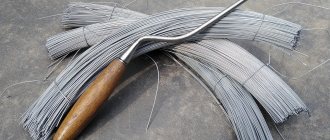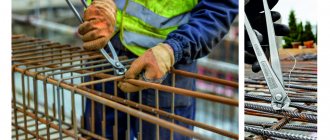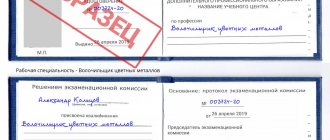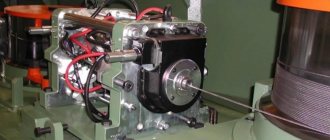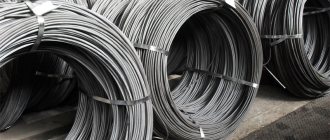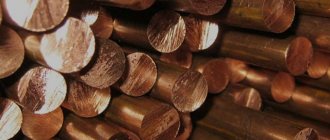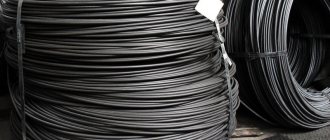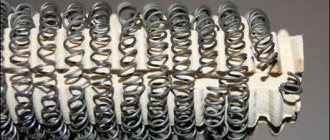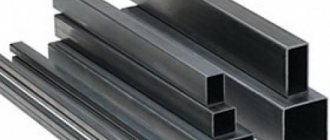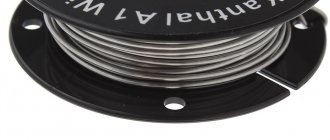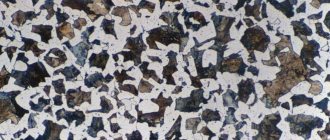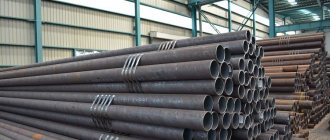Main product characteristics
The blank for the production of knitting wire is wire rod, which is cold drawn. The starting material is low-carbon steel with a carbon content of up to 0.25%. An important technological process in the manufacture of these products is heat treatment - annealing, which consists of heating the wire followed by slow cooling in furnaces - bell-type, shaft, linear type. The purpose of this operation is to restore the crystal lattice of steel, deformed during cold drawing, and to reduce residual stresses in the metal. Wire that has not undergone heat treatment bends poorly and often breaks and breaks. Annealed products are convenient for tying knots, and most importantly, they firmly fix the reinforcement in the installed position.
There are two types of annealing used in the production of tying wire for reinforcement:
- light - carried out in bell furnaces in the presence of inert gas. The surface of such products is clean without scale, the cost is higher. In the marking, this type of maintenance is designated by the letter “C”;
- dark - occurs in the presence of oxygen, so the surface of the wire turns out dark, with the presence of scale. Products after such heat treatment are marked with the letter “C”. Scale deteriorates the appearance of products and remains on the hands of workers, but the mechanical characteristics are not reduced.
Types and comparative characteristics
According to the main characteristics specified in GOST 2333-80, the wire is classified according to the shape and type of section, size, composition, surface treatment and finishing, area of use:
| Rental form | Section size | Chemical composition | Surface treatment | Surface finishing | Destination |
| Round | 1 group: up to 0.1 mm | Low carbon steel (carbon content no more than 0.25%) | Thermal | No additional finishing | Universal, general purpose |
| Shaped | Group 2: 0.1-0.2 mm | Carbon steel (more than 0.25%) | Released | Pulled after turning, grinding, roughing | For reinforcement of stressed metal structures |
| Rectangular | Group 3: 0.2-0.4 mm | Alloy steel | Annealed | Sanded | surfacing |
| Square | Group 4: 0.4-0.8 mm | High alloys | Normalized | Polished | Welding |
| Triangular | 5 group: 0.8-1.6 mm | Special types of alloys: heat resistant; corrosion resistant; heat resistant; precision. | Combined (tempered hardened) | Etched | Spoke |
| Trapezoidal | 6 group: 1.6-4 mm | Patented | With a metallic finish: · tinned; · with galvanization; · with copper coating; · coated in aluminum or brass. | Ropeway | |
| Hexagon | 7 group: 4-6 mm | Stabilized (processing under voltage) | With a finishing non-metallic coating (phosphated, with polymer painting) | For flexible pull of arrows and signals | |
| Oval | 8 group: 6-8 mm | Unheated | Treated light with tarnished colors | For reinforcing products of various types | |
| Z-shaped | 9 group: more than 8 mm | Cold rolled | Heat treated black with scale | Spring | |
| Segmental | Cold drawn | String; For the production of reinforcing mesh | |||
| X-shaped | Heat drawn (hot rolled) | For the production of cables of various types and purposes | |||
| Special profile | Calibrated | Bandage | |||
| Periodic profile | Linking |
The most commonly used wire types are:
● made of low-carbon steel (universal, complies with GOST 3282-74);
● made of low-carbon steel, cold-drawn (used for knitting and reinforcing concrete products, complies with GOST 6727-80);
● carbon steel (used for stressed reinforced concrete structures, knitting metal frames, complies with GOST 7348-81);
● welding steel (universal, complies with GOST 2246-70);
● made of low-carbon steel (general purpose, complies with GOST 3282-74).
Surface type and finish can be customized according to customer's requirement. Most often, standard black wire is used, but when in contact with aggressive environments, light galvanized wire or with protection in the form of polymer painting is recommended. Protective coating of copper, brass, and aluminum is also allowed to impart the required properties to the rolled product.
Galvanized Tie Wire
To increase the corrosion resistance of long products and expand the scope of their application, various types of metal coatings are used, galvanizing being the most widely used. Two types of this process are common in industry.
- Hot galvanizing is one of the best in terms of quality and durability. The protective layer is applied to a washed, degreased, pickled, fluxed and thoroughly dried surface. This process, carried out by drawing through a bath of molten zinc, is highly productive, but energy-intensive and requires environmental safety measures. This can be done several times until the required thickness of the protective layer is obtained.
- Galvanic galvanizing provides a thinner, but rather dense, protective layer than with the hot process. This technology requires less energy and is more environmentally friendly, and has become widespread abroad. This method of galvanizing binding wire is regulated by GOST 3282.
Scope of application of knitting wire
In addition to its main application in construction, wire for tying reinforcement is often used in other areas:
- Manufacturing of ropes.
- Production of masonry nets.
- Making barbed wire.
- Production of chain-link mesh.
- Product packaging.
- Securing cargo for transportation.
Knitting wire is most popular in monolithic construction. It is used for reinforcing the following reinforced concrete and concrete products:
- Foundations.
- Walls, lintels, beams, columns.
- Stairs.
- Monolithic floors.
- Floor screed.
Classification of wire for tying reinforcement
GOST 3282-74 “Low-carbon steel wire for general purposes” indicates its classification according to the following criteria:
By type of processing
– with or without heat treatment (annealing).
By type of coverage
– with or without galvanized coating.
According to manufacturing accuracy
– with increased or normal accuracy.
According to temporary tensile strength
(for unannealed) – groups I and II.
Also, the wire for knitting can be light or black. Black is obtained by annealing in air, with the usual oxygen content. Light is obtained as a result of annealing in an environment of inert gases. In terms of parameters, light wire annealed in an inert gas is no different from black wire, but is more expensive.
How to make wire for knitting
The main technology for producing wire for tying reinforcement is drawing. The steel blank is pulled through a special device (drawing machine). Its peculiarity is the presence of a gradually decreasing internal diameter. When drawn through such a hole, the metal is compressed and at the exit forms a product of the required cross-section and dimensions.
Drawing is a cold process. During this production, steel crystals are compressed, forming a dense lattice. The drawn wire, due to pressure treatment, is characterized by high hardness. However, such material is not flexible and brittle. In this state it is less suitable for tying reinforcement. When bent, it may crack at the bend.
To give the product the desired properties of ductility and bending strength, the resulting workpiece is sent to the furnace for annealing. It is heated to high temperatures and subjected to tempering (gradual cooling). During heat treatment, the structure of the iron lattice is normalized. Due to this, the final product will have sufficient flexibility, strength and becomes suitable for tying in reinforcement work.
The marking of the annealed material must contain the designation “O”. There are heat-treated soft wires for knitting:
- Black. The workpieces are heated using oxygen. In the process, the metal oxidizes, which makes it less durable and resistant to stress. The cost of this type of binding wire is the lowest. But it is not suitable for the construction of critical structures.
- Gray. Produced using inert gases when heated in an oven. Due to the lack of access to oxygen, iron does not oxidize, maintaining the required qualities: strength, flexibility, corrosion resistance. This building material can be used for tying reinforcement in the construction of load-bearing structures, foundations, etc.
GOST for tying wire
The term “knitting” itself is not introduced by GOST; instead, the term “general purpose” is used, since this type of metal product, in fact, is intended not only for construction and tying reinforcement. Its properties are such that it can be used equally effectively for domestic, production, and transportation purposes, which is determined by:
- the softness of a steel rod;
- flexibility with high strength;
- small diameter;
- absence or presence of surface treatment;
- low price.
For production, low-carbon steel is used, from which a cord of the required diameter is formed by drawing. This cord can be subjected to additional heat treatment or left untreated, after which it is formed into coils and sent to the buyer, or covered with an additional protective layer, and only then sold. Coated tying wire lasts longer as it is more resistant to corrosion.
Modern production
To obtain knitting wire (St. Petersburg) , take a wire rod with a cross-section from 5.5 to 6.5 millimeters. Since an ordinary long product forms creases on the folds (especially if they are at an acute angle), the elasticity of the product increases. For this purpose, special additional annealing is used.
There are three annealing modes in total. Full involves heating up to 900 degrees Celsius. The metal is kept at this temperature for some time, then it cools slowly and smoothly so that sudden temperature changes do not destroy it. Low-temperature annealing is obtained by heating to 500-600 degrees Celsius; this is used when it is necessary to relieve internal stress. To make the steel softer, partial annealing with heating is used, heating the product only to 470-480 degrees Celsius.
Annealing in this case can be black and white. You can easily distinguish them by the color of the final knitting wire. The dark color is due to scale, which is formed if the product is fired in a normal atmosphere. A white color is obtained if the same procedure is performed in a special oven in an atmosphere of inert gas, when an oxidizing dark film does not form.
VR wire, which can be purchased from the warehouses of METAL GROUP SPB, is additionally coated with a protective layer of zinc against corrosion to increase its service life. The most commonly used is hot-dip galvanizing, which prevents further oxidation of the product surface.
Features of the production of wire for knitting reinforcement
Material: low carbon steel. The technological process is drawing the workpiece through die holes with the required diameter. During drawing, the structure of the steel improves and a hardened layer is formed on its surface. But after this, large internal stresses appear in the metal. Therefore, the following technological operation is carried out - stress-relieving annealing. After this, the material acquires the main positive properties: good bending strength and high ductility.
